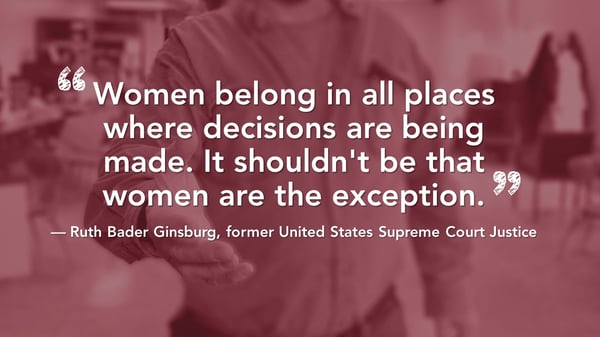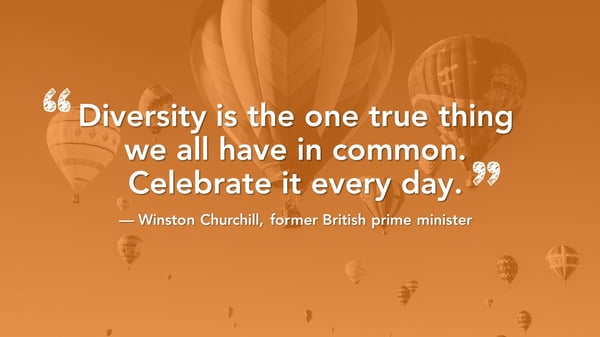As the world honors International Women’s Day on March 8, we at Entelechy would like to pay tribute to all of the incredibly successful and strong female leaders we’ve had the pleasure of working with and learning from over the years, including clients, trainers, and, of course, our (nearly) all-female team. And, in the spirit of empowering the next generation, we polled our inspiring network to determine how organizations can truly create a culture of leadership for all employees.

1. Recognize the unique talents of female leaders.
Not surprisingly, nearly everyone we spoke with cited how important it is for organizations to truly understand the various skills women leaders bring to the table. Skills like intuition, empathy, listening, team-building, organization, humility, and the ability to inspire transformation in others. Above all, we consistently heard that women are master communicators. Entelechy’s own Tina Harriman noted that women “consider the impact on others when communicating which in turn can create a healthier, more productive work environment for everyone.”
2. Leverage those skills to impact the bottom line.
It’s not enough to just take stock of those skills. Organizations must put them to work. One way to do that is to assess how the unique skills of your female leaders can help achieve your overarching business objectives and then create a culture of leadership where those skills can thrive. Senior executives need to support this shift and coach and motivate employees accordingly.
3. Acknowledge and mitigate existing gender bias.
Women currently hold 4.8% of Fortune 500 CEO roles. While that percentage increases further down the food chain, a lack of exposure to female leaders can often create damaging preconceived gender biases among employees — male and female. According to Marie Daniels, Program and Change Management Consultant of Customer Service at Broadcom, the first steps is to acknowledge the reality of your workplace, discuss biases that might be acting as roadblocks, and identify opportunities to remove those roadblocks. It’s important to repeat this process frequently to ensure progress is being made.
4. Connect on a personal level.
 In this day and age, all employees crave work-life balance. We at Entelechy, for instance, all work remotely and have the ability to attend to important life events during “normal” working hours. Even if your organization isn’t in a position to be that flexible, encouraging your leaders to form personal connections with their direct reports can go a long way in establishing trust, collaboration, and accountability. Women, in particular, appreciate knowing that their colleagues care about them as people first, employees second.
In this day and age, all employees crave work-life balance. We at Entelechy, for instance, all work remotely and have the ability to attend to important life events during “normal” working hours. Even if your organization isn’t in a position to be that flexible, encouraging your leaders to form personal connections with their direct reports can go a long way in establishing trust, collaboration, and accountability. Women, in particular, appreciate knowing that their colleagues care about them as people first, employees second.
5. Connect on a professional level.
Several of our poll participants noted how women have an uncanny ability to form deep personal connections in the workplace. Organizations can harness that energy by establishing professional networks where senior female leaders can sponsor the next generation. Going beyond the concept of a traditional mentor, a sponsor is someone who “recognizes, elevates, promotes, celebrates” and advocates for another at every step of their career, states Dr. Christina Augustine, global HR leader (currently serving as the People & Culture Officer at Kids Help Phone) and 2016 Top 25 Most Innovative HR Tech Leader in Asia Pacific HRM.
6. Create a lasting culture of leadership.
Most major organizations have several female-centric initiatives in place. While that’s a great first step, the next phase should be to eliminate ad hoc initiatives and replace them with “sustainable, strategic, scalable, and consistent tools and solutions” that support and celebrate women leaders throughout their entire career, according to Dr. Augustine.
Establishing or altering your organization’s leadership DNA is much easier said than done, and it must encompass ALL leaders. At the end of the day, strong leaders — regardless of gender — inspire others to generate meaningful results. When thinking back over her career, Angela Kazazian, one of Entelechy's Expert Leadership Facilitators, observes the following about those strong leaders:
The good ones challenged me, supported me when I needed it. The good ones believed in me and trusted me, they knew my strengths and how to capitalize on them. They knew what I needed to develop and helped me to do it. The good ones could laugh with me and truly knew me. The good ones could help me realize I had made a mistake without making me feel like I was stupid. The good ones made me want to walk through fire for them, they inspired me to want to do the very best I could in my work. The good ones were tough on me when they had to be and made me better. The good ones told the truth and even when the news was bad, they delivered it and helped people work through it with minimal impact.
Sounds easy enough, right? Well, in truth, leadership — like that statement — is profoundly simple. And, when you account for the fact that every person you manage likes to be coached differently, leadership is also uniquely challenging. The techniques and processes that resonated especially well with Angela, for instance, might not work for another direct report, and a strong leader must recognize that and adjust her approach accordingly. The key here is creating a culture where leaders frequently connect with their employees, provide relevant and constructive feedback, and engage them in meaningful ways. In this environment, ALL of your organization’s leaders will thrive and inspire change.
How does your organization empower female leaders? Share your experiences in the comments.
